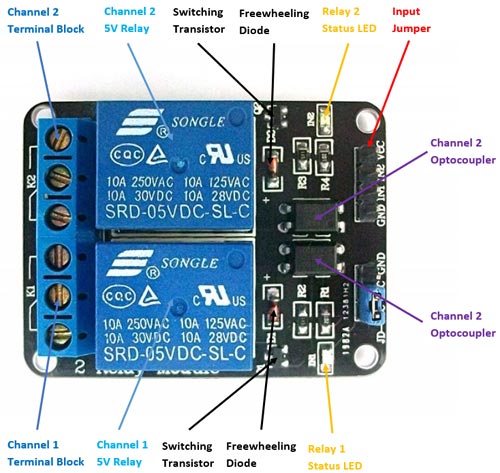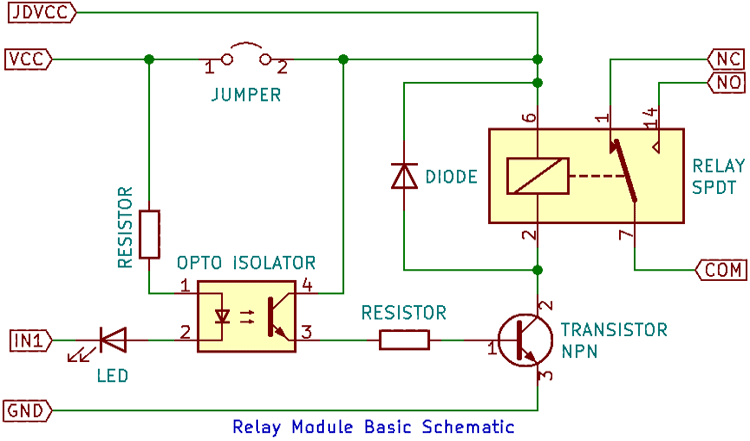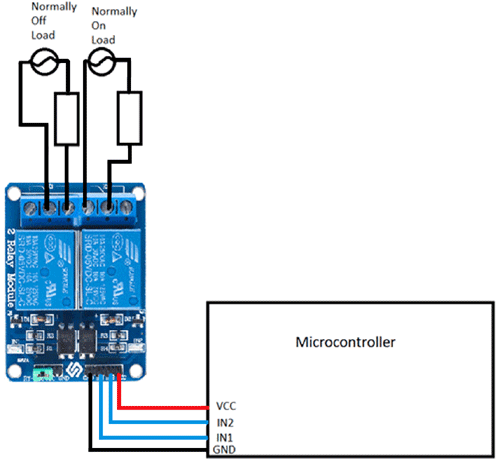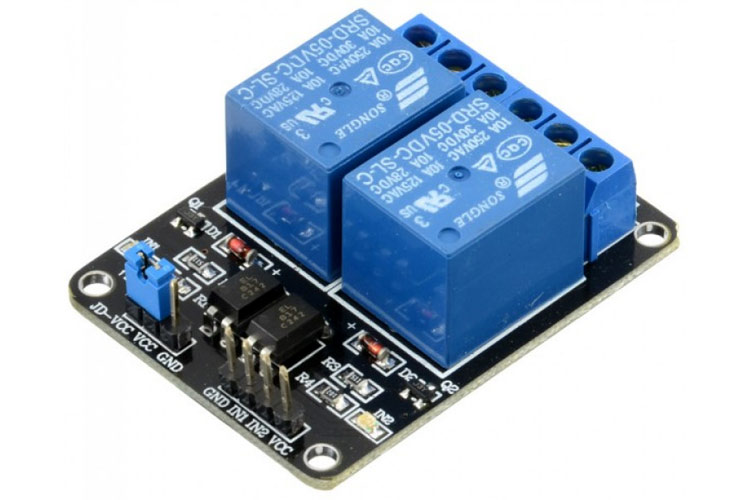5V Dual-Channel Relay Module
The dual-channel relay module is more or less the same as a single-channel relay module, but with some extra features like optical isolation. The dual-channel relay module can be used to switch mains powered loads from the pins of a microcontroller.
Dual-Channel Relay Module Pinout
|
Pin Number |
Pin Name |
Description |
|
1 |
JD-VCC |
Input for isolated power supply for relay coils |
|
2 |
VCC |
Input for directly powering the relay coils |
|
3 |
GND |
Input ground reference |
|
4 |
GND |
Input ground reference |
|
5 |
IN1 |
Input to activate the first relay |
|
6 |
IN2 |
Input to activate the second relay |
|
7 |
VCC |
VCC to power the optocouplers, coil drivers, and associated circuitry |
Dual-Channel Relay Module Specifications
- Supply voltage – 3.75V to 6V
- Trigger current – 5mA
- Current when relay is active - ~70mA (single), ~140mA (both)
- Relay maximum contact voltage – 250VAC, 30VDC
- Relay maximum current – 10A
Alternate Relay Modules
Single-channel relay module, four-channel relay module, eight-channel relay module.
Alternate Modules for AC switching
Solid State Relay module, SCRs, TRIACs
Components present on a 5V Dual Channel Relay Module
The following are the major components that would find on a Dual channel Relay module, we will discuss them in detail further in this article.
5V Relay, Optocoupler, Diodes, Transistors, Resistors, LEDs, Male Headers, 3-pin Terminal connectors, etc.
Understanding 5V Dual-Channel Relay Module

The dual-channel relay module contains switching relays and the associated drive circuitry to make it easy to integrate relays into a project powered by a microcontroller. On the left are two terminal blocks, which are used to connect mains wires to the module without soldering.
Next, come to the two relays. As marked on the body of the relay, the relay coil is rated for 5VDC, and the contacts are rated for 10A at 250VAC or 30VDC, or 125VAC or 28VDC.
The switching transistors amplify the signal from the inputs enough to drive the relay. The freewheeling diodes prevent voltage spikes across the switching transistors. The status LEDs turn on when the relay is active and indicate switching.
The optocouplers are used to provide additional isolation between the input and the relays. The isolation can be selected using the VCC/JDVCC jumper.
The input jumper has two input and two power pins and can be easily used to connect to jumper wires and other microcontrollers and sensors.
Internal Circuit Diagram for Dual-Channel Relay Module
The circuit on the board is as follows:

This same circuit is replicated twice on the module. There are several differences when compared to the single-channel relay module. The first is that the optocoupler and relay can have a separate power supply from the input. This is selected using the JD-VCC jumper – if the jumper is shorted, then the relay coil and optocoupler output are connected to the signal VCC. If the jumper is left open, a separate power supply can be provided to the relay coil through the JD-VCC pin.
The second is that the input is active low, meaning that the relay coil is activated only when the input is low. This is because the optocoupler input and the indicator LED are chained to VCC. When the input is high, the voltage difference across the chain is 0V and no current can flow, but when the input is low, supply voltage appears across the chain and the optocoupler output conducts, supplying current to the base of the drive transistor, turning the relay on.
How to use Dual-Channel Relay Module
The dual-channel relay module can be used to switch mains powered loads from the pins of a microcontroller. Since there are two channels on the same board, two separate loads can be powered. This is useful for home automation.
The loads can be connected as follows:

In this diagram, the relay on the left (channel 1) is connected in a regular fashion with the load and source going between common and normally open, so when the relay is activated, the load is powered. On the right channel (channel 2), the load and source are connected between common and normally closed, which means that the load is powered by default till the relay is activated.
If the load is connected to the normally closed contact, then the input polarity ‘reversal’ can be fixed – the load is powered on when the input is high, and the load is powered off when the input is low. This method, however, wastes some current since the relay coil draws current when the load is switched off.
Dual-Channel Relay Module Basic Troubleshooting
If either of the relays does not turn on:
- The contacts might be welded due to overcurrent/arcing. Shaking the module firmly might help unstick the contacts
- The driver circuitry might have been damaged due to overvoltage.
- Input polarity might be incorrect.
- Jumper might not have been moved to the correct position
Dual-Channel Relay Module Applications
- Switching mains loads
- Home automation
- Battery backup
- High current load switching











